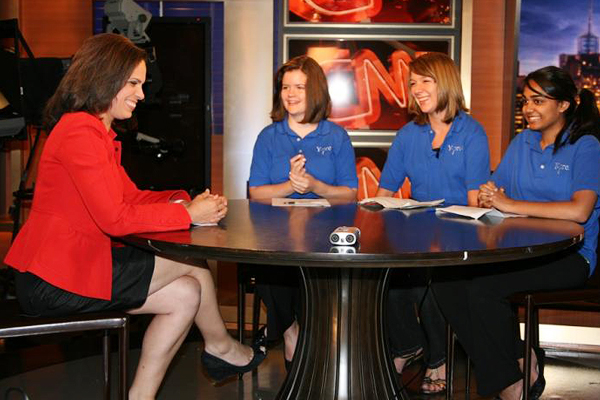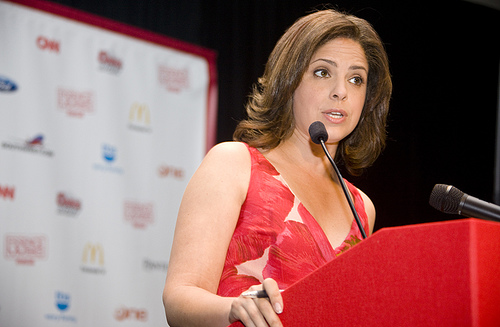Power of the Question
Lesson 1: Identifying Tone
Resources/materials
- Chart paper and/or white board
- Online video access w/ speakers
- Index cards
- Overhead or computer projector
- Markers
- Soledad O’Brien biography
- Soledad O’Brien video
- Buddy Warren and Andrew Young interviews from “Black in America”
- Short biographies of five to six famous people from a variety of backgrounds

WARM-UP ACTIVITY
Prior to class, write the word “tone” on the board. Ask students individually brainstorm synonyms for it, listing in their responses in journals.
List students’ responses on the board. Using this list, ask students if they think tone is important. Have students volunteer to share a story or experience when tone had an impact on a situation or conversation and what effect it had. Alternatively, the teacher can ask students the following question: “When an adult uses the phrase, ‘Don’t use that tone of voice with me,’ what are they referring to?”
CONCEPT FORMATION
The “Oh!” exercise. Prior to class, write short scenarios on index cards.
Examples: You just got the birthday present you’ve been wishing for; someone walks up behind you and scares you; you got an A on your project; or you found out your best friend stole your boy-/girlfriend.
Ask for several student volunteers to come to the front of the class to read their scenario first silently and then act out how they would react using only the word “Oh.” Ask students first to verbalize their version of “Oh,” then try using facial expressions without verbalizing, and finally put together the verbalization and facial expressions. Have the other students try to guess what emotion is represented (happiness, sarcasm, sadness, happiness, fear, surprise, etc.). Repeat the exercise with several students. Then debrief this activity by asking students how tone helped to determine emotion.
Using the debriefing and students’ responses elicited during the warm-up activity, create a working definition of tone and write the definition on board.
Ask students how this definition might apply to journalists or other people who ask questions for a living. Introduce one journalist, CNN’s Soledad O’Brien, who understands the importance of tone in asking questions.
Possible activities to introduce O’Brien:
- Ask students to write down words or phrases to the following questions:
- What do you think of when you hear the name Soledad?
- What about the name O’Brien?
Show a photograph of Soledad O’Brien on the overhead projector.
- Soledad photo
- Ask students to share their comments about her appearance, her name, and their assumptions regarding her ethnic background and identity.
Hand out a short biography of Soledad O’Brien to the class.
- Short bio for Soldedad O’Brien
- Have students pair up and read the biography in teams or small groups.
- Optional homework assignment is to finish reading the biography and/or to further investigate Soledad O’Brien online (Google search)
Show the first section of the O’Brien video, which includes O’Brien’s interview with Buddy Warren from “Black in America.”
Ask students:
- How does O’Brien’s tone have an impact on the interview?
- What type(s) of tone does she use?
- Can one’s tone help explore a controversial or sensitive topic?
APPLICATION
Ask students find a newspaper columnist and list words that describe the overall tone of journalist’s column; write these words in their journal (e.g., exasperated, disgusted, sarcastic, impatient, targeted assault). Then ask them to exchange columns with another student and allow time for students to make a tone word list for the second column (fed up, bored, general malaise) as they did for the first. You may want to provide a list of tone words for them to refer to (google fccj.edu tone words). Teacher might identify columns in advance that are relevant to class’s area of study.
Have students select the best example of tone and share with the class.
Possible extensions
Ask students to view a political speech and describe the tone in one or more of these speeches. Why was the tone taken? Was the tone appropriate for the audience and content of the speech? Was the tone effective? Why or why not? How would the speech be different if it were delivered in a different tone?
Videos
President Obama
Restoring Tax Fairness
President Bush
Post 9/11 Speech
Winston Churchill
1941 Great Declaration
President Reagan
Tear Down This Wall
Ask students to read and discuss a novel that tells a story from multiple points of view (The Sound and The Fury, Dinner at the Homesick Restaurant, The Poisonwood Bible). Discuss how tone of each narrative helps the reader understand a point of view and how the different tones are used as literary elements. Divide students into groups and have each group choose one narrative to compare to the others using a graphic organizer. Use an organizer to list page numbers and quotations that helped them reach their conclusions.



